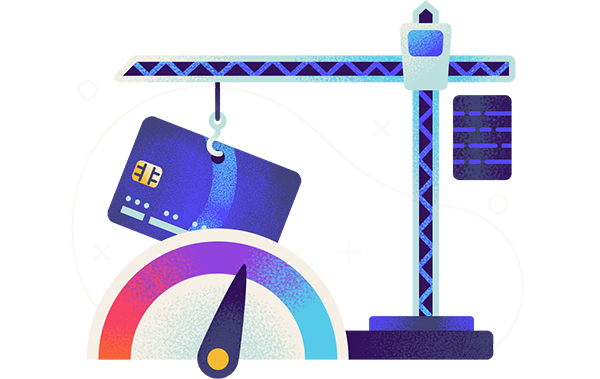The best way to build credit with a credit card is to:
- Apply for a secured credit card or a starter credit card.
- Set up automatic monthly bill payments from a bank account.
- Use less than 30% of your credit limit (ideally 1%-10%).
- Pay your full balance by the due date (to save on interest, too).
- Become an authorized user on a family member’s card to build credit faster.
- Use WalletHub to monitor your credit.
The key to building credit is to get a credit card as soon as possible and then avoid missing monthly due dates. Simply having an open credit card account is the easiest way to build credit, and payment history is the biggest ingredient in your credit score.
It’s even possible to build credit with a credit card without making purchases, because information about your account still gets reported to the credit bureaus on a monthly basis. It’s also important to regularly monitor your credit to make sure that there are no errors falsely bringing down your score.
Get Personalized Tips With WalletHub's Free Credit Analysis
How to Use a Credit Card to Build Credit
Pick the Right Credit Card
If you’re building credit for the first time, you’ll likely want to go with either a secured credit card or an unsecured starter credit card with no annual fee that reports to all three major credit bureaus (Equifax, Experian and TransUnion) on a monthly basis. That way, you can focus on building credit as inexpensively as possible. Other perks such as rewards are nice to have, but not essential.
It’s important to do research before you apply for a credit card. Consider your needs, then compare the terms of cards that cater to those needs. You can use WalletHub’s credit card comparison feature to help.
Make Purchases
Making purchases and paying them off demonstrates to creditors that you can handle debt responsibly and be trusted to stick to payment deadlines. If you never borrow money, it’s harder for creditors to predict how you would act if you did. That’s why, even though it may seem counter intuitive, utilizing at least 1% of your credit (but less than 30%) is actually better for your credit score than 0% utilization. So, you should make purchases every month, then pay them off before your due date.
However, even if you don’t use your credit card, you’ll still have positive information reported to the credit bureaus every month, because your account is “current” and you aren’t desperate to use your available credit. That will help you build your score. It might just take a little longer.
Make On-Time Payments
You’ll typically have a grace period of 21 to 25 days to submit payment for your charges before you owe any interest. Ideally, you should pay as soon as you receive your statement, so there’s no possibility you’ll be late.
You should strive to pay in full, too, or else you’ll lose that grace period and owe interest right away on new purchases. If that happens, you’ll have to pay your balance in full for two consecutive months to get your grace period back. If you pay in full every month, you can avoid interest charges completely.
The best way to ensure that you pay on time is to set up automatic payments. If you do that, you’ll never be late unless you don’t have enough money in your linked bank account.
What Happens if You Miss a Payment?
Missing a payment is the worst thing you can do to your credit because payment history makes up the largest percentage of your credit score. Being late presents you as untrustworthy, which will make qualifying for future credit cards, loans and credit limit increases more difficult.
The good news is that your credit card issuer won’t report you as late to the credit bureaus unless you’re at least 30 days delinquent, so if you pay by then, you can avoid credit score damage. The bad news is that being late on your original due date still causes you to owe a late fee and lose your grace period for future purchases.
Keep Your Credit Utilization Low
Using more than 30% of your credit limit risks damage to your score. Having 1%-10% utilization will help your score the most. You also shouldn’t spend beyond your means, regardless of what your credit limit is.
You can see your latest credit utilization rate through your online account with your credit card issuer. You can also check your credit utilization for each credit account you own, as well as your overall utilization, via your free WalletHub account.
To improve your credit utilization, pay down part of your balance before the end of your monthly billing period. The utilization you have the day your statement closes is what gets reported to the credit bureaus and what ultimately affects your credit score. For example, if you have a $1,000 credit limit and spend $500 of it in a month but pay down $400 before your statement closes, your issuer will only report a 10% credit utilization rather than 50%.
Check Your Credit Score & Report Regularly
You can check your latest credit score and credit report for free here on WalletHub. This will help you track your progress and make sure you stay on the right path. It allows you to catch errors on your report and dispute them, too, which can help your score.
As a WalletHub user, you’ll also get access to free personalized advice on how to improve your credit score.
Become an Authorized User
If you’re too young to get a credit card (less than 18 years old) or you simply haven’t had luck getting an account, there’s still a way for you to build credit with a credit card. You can become an authorized user on someone else’s account. That means you’ll receive a card connected to that person’s account and be able to make purchases drawing on their credit limit.
The primary account holder is responsible for making payments, but the account information will appear on your credit report too. Being an authorized user won’t help you build credit as quickly as with your own card, but it’s certainly worthwhile.
What Not to Do When Building Credit With a Credit Card
There are a few pitfalls that can trip you up when you’re building credit with a credit card. To avoid hurting your credit score or losing money, keep these tips in mind:
- Do not make purchases you can’t afford, as that leads to costly interest and credit score damage if you don’t pay on time.
- Do not carry a balance from month to month if possible, or else you’ll owe interest and lose your grace period on new purchases.
- Do not use more than 30% of your credit limit, as that’s bad for your credit score. If you need to exceed 30% for a purchase, pay off at least some of what you owe before your monthly billing period ends. Only your balance at the time your statement closes gets reported to the credit bureaus.
- Do not miss a payment, because on-time payments are a huge factor in your credit score. If you do miss one, get current before you’re 30 days late to avoid credit score damage. Then, pay in full for the next two consecutive months to restore your grace period.
- Do not apply for more than one credit card within six months, in order to give your credit score time to recover from the 5-10 point drop caused by the hard inquiry when you apply.
Best Credit Cards to Build Credit With
There are lots of good credit cards to build credit with, including starter credit cards, credit cards for college students, and credit cards for bad credit. The best ones don’t charge annual fees and have approval requirements that are easy to meet. Below, you can find a handful of the most popular choices.
Opinions and ratings are our own. This content is not provided, commissioned or endorsed by any issuer. WalletHub independently collected information for some of the cards on this page.
How to Build Credit Without a Credit Card
A credit card is one of the best tools for building credit, but there are still plenty of ways to establish a credit history without a credit card – including:
Taking out a loan.
The easiest type of loan to get with no credit history is a secured personal loan, which requires collateral, though you may be able to qualify for some unsecured personal loans. You might also be able to borrow money through peer-to-peer lending sites or qualify for a student loan. All of these sources will help you build credit, assuming they’re through reputable lenders that report to the credit bureaus on a monthly basis.
Getting a credit-builder loan.
This type of loan deserves its own category because it’s basically the opposite of a regular loan. With a credit-builder loan, the lender puts aside money in a savings account for you, then you make monthly payments until the balance is paid off, with a small amount of interest. The lender reports your payments to the credit bureaus each month, which builds your credit, and you get the money in the savings account at the end.
Reporting your rent or utility payments.
In some cases, your landlord might report rent payments to the credit bureaus. But if they don’t, there are a number of third-party services that will help you get information about on-time rent payments onto your credit reports, for a fee. You may also be able to use these services to report on-time payments for your utility bills.
You can learn more about how to build credit without a credit card here on WalletHub.



WalletHub experts are widely quoted. Contact our media team to schedule an interview.